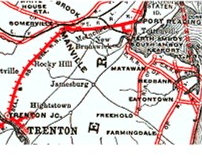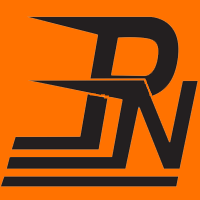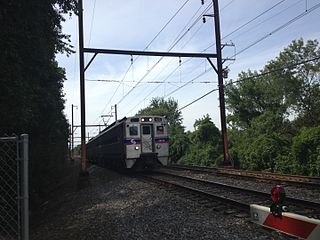
The SEPTA Regional Rail system is a commuter rail network owned by SEPTA and serving the Philadelphia metropolitan area. The system has 13 branches and more than 150 active stations in Philadelphia, Pennsylvania, its suburbs and satellite towns and cities. It is the sixth-busiest commuter railroad in the United States, and the busiest outside of the New York, Chicago, and Boston metropolitan areas. In 2016, the Regional Rail system had an average of 132,000 daily riders and 118,800 daily riders as of 2019.
The National Railway or National Air Line Railroad was a planned railroad between New York City and Washington, D.C. in the United States around 1870. Part of it was eventually built from New York to Philadelphia by the Delaware and Bound Brook Railroad and the Delaware River Branch of the North Pennsylvania Railroad, leased by the Philadelphia and Reading Railway, in 1879, and becoming its New York Branch. The line was intended to provide an alternate to the various monopolies that existed along the route, specifically the United New Jersey Railroad and Canal Companies and their Camden and Amboy Railroad, and as such had a long struggle to be built.

The SEPTA Main Line is the section of the SEPTA Regional Rail system from the Zoo Interlocking in West Philadelphia to Lansdale Station in Lansdale, Pennsylvania. The line is 26.25 miles (42.25 km) long, and serves all 13 SEPTA Regional Rail lines.

Jenkintown–Wyncote station is a major SEPTA Regional Rail station along the SEPTA Main Line in Montgomery County, Pennsylvania. It is located at the intersection of Greenwood Avenue and West Avenue on the border of Jenkintown and the Wyncote neighborhood of Cheltenham Township, with a mailing address in Jenkintown. It is the ninth-busiest station in the regional rail system, and the fourth busiest outside Center City. Despite this, the station is not wheelchair accessible. SEPTA had plans to make the station wheelchair accessible by 2020, but these have not yet been completed.

Wayne Junction station is a SEPTA Regional Rail junction station located at 4481 Wayne Avenue, extending along Windrim Avenue to Germantown Avenue. The station is located in the Nicetown neighborhood of Philadelphia. Wayne Junction serves as a multi-modal transfer point between six of SEPTA's regional rail lines as well as three major transit routes – the Route 75 Trackless Trolley and the Route 23 and 53 bus lines. The station served more than 321,000 riders annually in 2018.

The Port Reading Railroad was a railway company in the United States. It was incorporated in 1890 and completed its main line in 1892. It was controlled throughout its corporate life by the Reading Company. The Port Reading Railroad's line was conveyed to Conrail in 1976, and is today the Port Reading Secondary.
The North Pennsylvania Railroad was a railroad company which served Philadelphia, Montgomery County, Bucks County and Northampton County in Pennsylvania. It was formed in 1852, and began operation in 1855. The Philadelphia and Reading Railway, predecessor to the Reading Company, leased the North Pennsylvania in 1879. Its tracks were transferred to Conrail and the Southeastern Pennsylvania Transportation Authority (SEPTA) in 1976.

The Connecting Railway was a subsidiary of the Pennsylvania Railroad, incorporated to build a connection between the Philadelphia and Trenton Railroad and the PRR in the city of Philadelphia.

The Trenton Subdivision is a railroad line owned by CSX Transportation in the U.S. states of Pennsylvania and New Jersey. The line runs from CP NICE in Philadelphia, Pennsylvania, northeast to Port Reading Junction in Manville, New Jersey, along a former Reading Company line.

The Harrisburg Line is a rail line owned and operated by the Norfolk Southern Railway (NS) in the U.S. state of Pennsylvania. The line runs from Philadelphia west to Harrisburg.

The Schuylkill Branch was a rail line owned and operated by the former Pennsylvania Railroad (PRR) in Pennsylvania. The line ran from the Philadelphia to Harrisburg Main Line at 52nd Street in Philadelphia north via Norristown, Reading, and Pottsville to Delano Junction, about 2.5 mi (4.0 km) northeast of Delano. From Delano Junction, the PRR had trackage rights over the Lehigh Valley Railroad's Hazleton Branch and Tomhicken Branch to Tomhicken, where the PRR's Catawissa Branch began.
The Philadelphia, Newtown and New York Railroad was a railroad in southeastern Pennsylvania that is now a part of the SEPTA commuter rail system as the Fox Chase Branch. Despite the name, it only ever extended between Philadelphia and Newtown, Pennsylvania.

The West Trenton Line is a SEPTA Regional Rail service connecting Center City Philadelphia to the West Trenton section of Ewing Township, New Jersey. With around 12,000 riders every weekday, it is the third busiest line in the SEPTA Regional Rail network.

The Fox Chase Line is a SEPTA Regional Rail service connecting Center City Philadelphia with Fox Chase. It uses the Fox Chase Branch, which branches off from the SEPTA Main Line at Newtown Junction north of the Wayne Junction station. It runs entirely within the city of Philadelphia. The line is fully grade-separated, except for one grade crossing on Oxford Avenue.

The Pennsylvania Northeastern Railroad is a short-line railroad operating on trackage mostly in Bucks and Montgomery counties to the north of Philadelphia, Pennsylvania. It was created in 2011, taking over former operations from CSX Transportation. The Pennsylvania Northeastern Railroad interchanges with CSX in Lansdale, the East Penn Railroad in Telford, and the New Hope Railroad in Warminster.

The New York Branch or the Bound Brook Route was a railway line in Pennsylvania and New Jersey. It was operated by the Reading Company and owned by two of its subsidiaries, the North Pennsylvania Railroad and the Delaware and Bound Brook Railroad. It formed part of the Reading's route from Philadelphia to New York City, used by the famed Crusader. The line was transferred to Conrail in 1976 and was split into the Neshaminy Line and Trenton Line. SEPTA continues to operate commuter trains to West Trenton as part of its West Trenton Line.

The Ninth Street Branch was an elevated railway line in Philadelphia, Pennsylvania. It was operated by the Reading Company; ownership was split between the Reading and its subsidiary the Philadelphia, Germantown and Norristown Railroad. It was a four-tracked main line beginning at the Reading Terminal, the Reading's terminus in Philadelphia, and extending north into the city to a junction with the Bethlehem Branch. After the final bankruptcy of the Reading the line passed to Conrail and later SEPTA. The portion south of the Temple University station was abandoned in 1984 with the opening of the Center City Commuter Connection and is now known as the Reading Viaduct; the portion north is now part of the SEPTA Main Line.

The Neshaminy Line is a railway line in the states of Pennsylvania and New Jersey. It runs 21.7 miles (34.9 km) from a junction with the SEPTA Main Line just north of Jenkintown–Wyncote to West Trenton, just across the Delaware River. It was originally built in 1876 as part of the much longer New York Branch, which continued north to Bound Brook, New Jersey. The electrified section between Jenkin and West Trenton was designated the Neshaminy Line and is now owned by SEPTA. It hosts the West Trenton Line commuter rail service. The freight-only Trenton Subdivision runs parallel between Neshaminy Falls and West Trenton.
The Chestnut Hill East Branch is a railway line in Pennsylvania. It runs 5.5 miles (8.9 km) from a junction with the SEPTA Main Line in Nicetown–Tioga, a neighborhood in Philadelphia, to Chestnut Hill, Philadelphia. The oldest part of it was built in 1832 by the Philadelphia, Germantown and Norristown Railroad. It was part of the Reading Company system from 1870 until 1976. Today it is owned by SEPTA and hosts the Chestnut Hill East Line commuter rail service. The line runs roughly parallel to the Chestnut Hill West Branch, formerly of the Pennsylvania Railroad.
The Fox Chase Branch, formerly the Newtown Branch, is a railway line in the state of Pennsylvania. It runs 4.9 miles (7.9 km) from a junction with the SEPTA Main Line near Wayne Junction to Fox Chase. At its fullest extent, it continued another fifteen miles north to Newtown. The oldest part of it was built in 1876 by the Philadelphia, Newtown and New York Railroad. It was part of the Reading Company system from 1879 until 1976. Today it is owned by SEPTA and hosts the Fox Chase Line commuter rail service.















